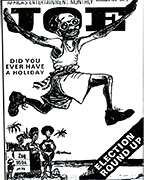Joe (magazine)
 | |
| Editor | Terry Hirst, Hilary Ng'weno, Oscar Festus |
|---|---|
| Categories | Youth Magazine |
| Frequency | infrequently |
| Circulation | 10,000-30,000[1] |
| First issue | 1973 |
| Final issue | 1979 |
| Company | Private |
| Country | Kenya |
| Language | English |
| Website | |
Joe was a popular magazine published in Kenya in the 1970s, at the height of what acclaimed publisher Henry Chakava described as the "fat years" of Kenyan publishing. Joe magazine was one in a number of popular publications aimed at the new urban middle and lower-middle classes. What set Joe magazine apart was its subversive use of humour, as well as its use of art and fiction as a narrative frame for cultural, social and political analysis. This strategy was seminal not only in educating and activating its readers but also in providing a platform for new fiction writers and artists to develop their talents.
Founded by writer/publisher Hillary Ng'weno and artist Terry Hirst, Joe magazine published regularly between 1973 and 1979. The magazine was named after "Joe", a common man who used humour to deal with and expose the realities of urban life in contemporary Africa. This epitomized Joe magazine's aim; readers were encouraged to do the same, and enter into a dialogue with the character, and thus the magazine. Hirst described Joe as "a survivor who has to laugh to keep from crying."[2]
Taking its cue from Drum, Joe magazine employed street-wise language in comic strips, fiction stories and thematic columns to explore everyday problems of the urban population. Its letters column, "Dear Joe", like Drum's "Speak up Man", encouraged interaction from readers. The magazine also carried an original short story in every issue, nurturing writers such as Sam Kahiga and Meja Mwangi, and even Ngũgĩ wa Thiong'o, who occasionally contributed to the magazine. Joe's main distinguishing factor was its use of graphics, drawings, illustrated jokes and comic strips, such as "City Life" by Edward Gitau, "O.K, Sue! A City-Girl's View" by Kimani Gathingiri and Terry Hirst's "Daddy Wasiwasi & Co" and "The Good, the Bed and the Ugali", all of which created a lasting impression on Kenya's visual culture.
Ng'weno left Joe magazine in 1974 and in 1979 Hirst renamed the magazine Joe Homestead, increasing the number of comic strips and adding a new section on family, nutrition and health - perhaps to take Joe magazine from its original urban setting to a more rural one. However, the new title did not attract advertisers and the magazine shut down in August 1979.
References
- ↑ Frederiksen, p.97
- ↑ Bodil Folke Frederiksen; Raoul Granqvist (1993). "Living in the Neighbourhood of One's Dreams: The Role of Popular Writing in the Creation of the Ordinary". Culture in Africa: An Appeal for Pluralism. Nordic Africa Institute. p. 97. ISBN 91-7106-330-7.
This article uses text taken from Chimurengal Library under the GFDL